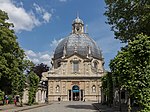Tielt-Winge
Flemish Brabant geography stubsMunicipalities of Flemish BrabantPages with Dutch IPA

Tielt-Winge (Dutch pronunciation: [ˌtiltˈʋɪŋə]) is a municipality located in the Belgian province of Flemish Brabant. The municipality comprises the towns of Houwaart, Meensel-Kiezegem, Sint-Joris-Winge and Tielt. On 1 January 2006, Tielt-Winge had a total population of 10,009. The total area is 44.16 km² which gives a population density of 227 inhabitants per square kilometre.
Excerpt from the Wikipedia article Tielt-Winge (License: CC BY-SA 3.0, Authors, Images).Tielt-Winge
Leuvensesteenweg,
Geographical coordinates (GPS) Address Nearby Places Show on map
Geographical coordinates (GPS)
| Latitude | Longitude |
|---|---|
| N 50.916666666667 ° | E 4.9 ° |
Address
Leuvensesteenweg
Leuvensesteenweg
3390
Flemish Brabant, Belgium
Open on Google Maps









